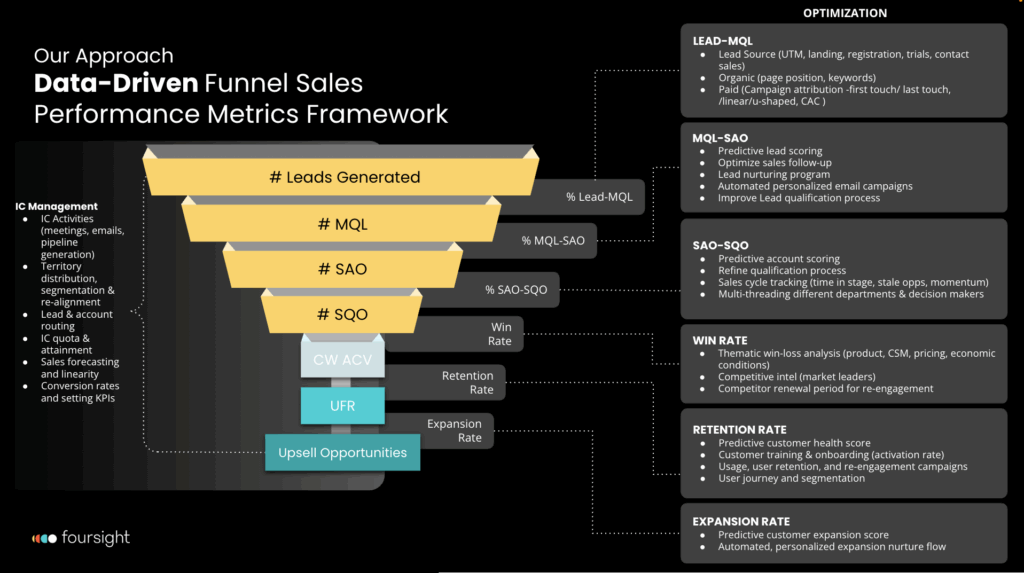Have you ever stared at a Salesforce dashboard and wondered which numbers actually matter? Metrics are everywhere. And they all matter in some capacity, to someone on the team or board. But after a while, some catch your eye, while others actually communicate the key insights you need to make meaningful decisions. The true challenge lies not in the abundance of metrics, but in discerning which numbers genuinely inform strategic decisions.
While some metrics offer immediate, satisfying boosts, often termed ‘vanity metrics’, their utility is contextual. For internal team discussions, these metrics can be invaluable for motivation and identifying nascent trends. However, when presenting to a board or making critical revenue projections, a different set of strategic KPIs becomes paramount for leaders.
Our experience navigating complex data environments reveals that a thoughtful approach to dashboard design, one that balances these different metric types, is crucial to avoid misleading insights and ensure every number serves a clear purpose.
In this article, we highlight the differences in contexts and the why and when around giving certain metrics attention, but stay tuned as we continue to go into detail on more Revenue Operations metrics in later posts, as we won’t be covering every detailed KPI today.
Vanity Metrics: Numbers That Are Fun but Context-Dependent
Vanity metrics are the eye-catching numbers on your great looking dashboards. They feel satisfying to watch it increase and are easy to showcase in reports. For marketers, examples might include website traffic, social media engagement, and total leads captured. Numbers like these, though, do not always directly indicate revenue outcomes, but they can be useful in the right context.
During early-stage campaigns, vanity metrics provide signals about engagement and resonance. They can also motivate teams by showing progress toward goals. Even spikes in webinar registrations or social media clicks can highlight trends worth exploring.
Based on our work with revenue operations teams, dashboards overloaded with vanity metrics often lead to distraction rather than insight. It’s key for organizations to identify which vanity metrics add real value and which ones are simply noise, ensuring early signals are captured without cluttering your reporting environment on the day-to-day.
Strategic KPIs: Metrics That Drive Decisions
Strategic KPIs reveal whether your revenue engine is actually performing efficiently and where adjustments may be needed. Examples include opportunity-to-close ratios, pipeline velocity, churn rates, and average deal size. These metrics provide clarity about performance and are central to operational and strategic decision-making.

In Salesforce, strategic KPIs might be closed-won percentages, lead-to-opportunity conversion rates, or campaign influence metrics. Unlike vanity metrics, these numbers directly influence resource allocation, forecasting, and process improvements.
Our Lane Four and Foursight Management Consulting teams often guide clients to build dashboards that prioritize KPIs without losing context. By focusing on metrics that answer the question, “What should I do next?” We turn dashboards into actionable tools that empower teams to make decisions that directly impact revenue outcomes.
Timing Matters: When to Focus on Each Metric
The value of a metric is closely tied to timing. During early campaigns, vanity metrics provide immediate feedback on engagement and interest. Tracking website visits, form submissions, and click-throughs in outreach emails can highlight what is working and what might need adjustment.
As campaigns progress, combining vanity metrics with strategic KPIs allows teams to detect bottlenecks, assess lead quality, and monitor conversion trends. Dashboards that track opportunity progression alongside engagement metrics reveal insights that inform mid-cycle decisions.
By quarter-end, strategic KPIs take center stage for executive reporting. Vanity metrics may provide context, but they don’t always drive decisions.It’s important for organizations to implement timing strategies to ensure that every metric on the dashboard serves its intended purpose, whether it is an early signal or a decision-driving KPI.
Balancing Metrics Without Overwhelm
Managing multiple metrics can feel overwhelming, but balance is achievable. Too much focus on vanity metrics creates noise, while ignoring them entirely can obscure early signals. At Lane Four, we work with clients to create dashboards that separate motivational metrics from decision-driving KPIs, keeping reporting clear and actionable. Every number should pass one simple test: does it change what I will do next? Regular audits help ensure metrics remain relevant and meaningful. A quick exercise we recommend is to pick one vanity metric and one strategic KPI from your dashboards and evaluate what story each tells. This simple step can quickly uncover gaps, eliminate unnecessary noise, and provide a roadmap for better reporting.
Taking Action: Next Steps for Revenue Leaders
Start by auditing your dashboards to clearly separate vanity metrics from strategic KPIs. Review recent team activity to understand how engagement translates into opportunity creation and revenue. Adjust strategies based on these insights, focusing attention on metrics that truly drive decisions. Sometimes, this is easier said than done; we know.
But by taking intentional steps, you ensure metrics support meaningful action, align teams around what matters, and provide clarity instead of distraction. The goal is not just to measure activity but to empower decisions that directly impact revenue outcomes.
Vanity metrics can provide context, early signals, and team motivation when used thoughtfully. Strategic KPIs are essential for informed decision-making, but their value is maximized when interpreted in context and at the right time.
The next time you look at your dashboards, ask yourself whether you are merely observing numbers or actively making them work for your revenue strategy. With Lane Four as a partner, you do not have to navigate this alone. Let’s chat!
